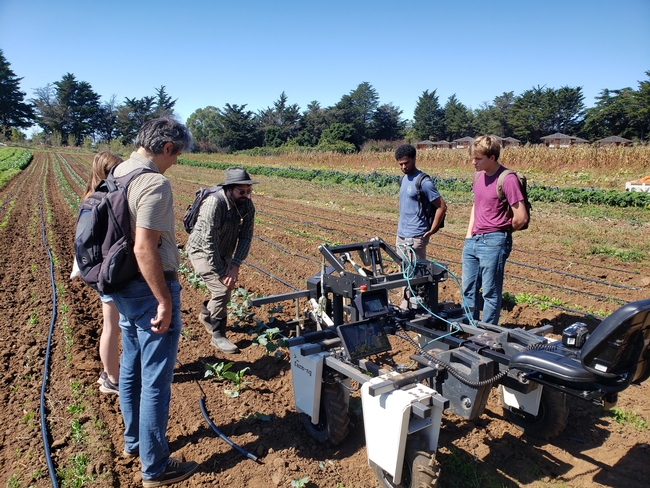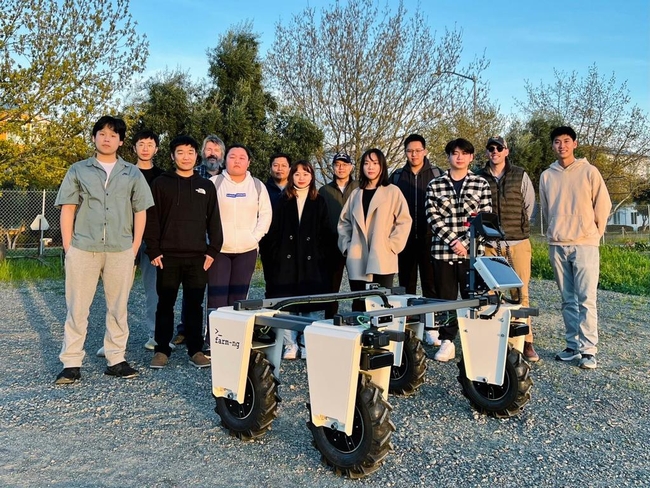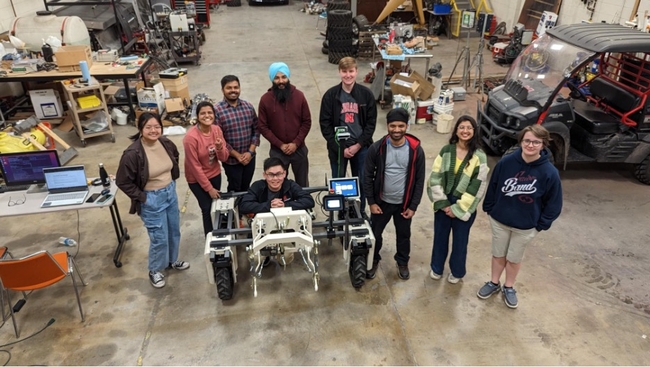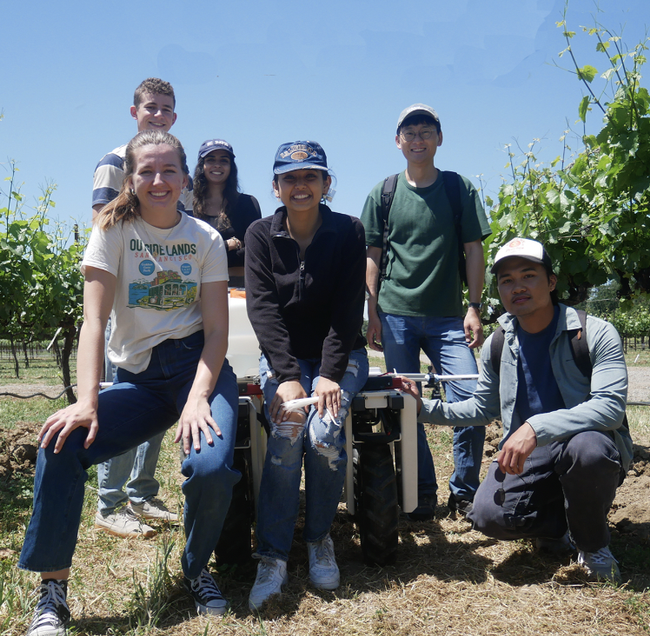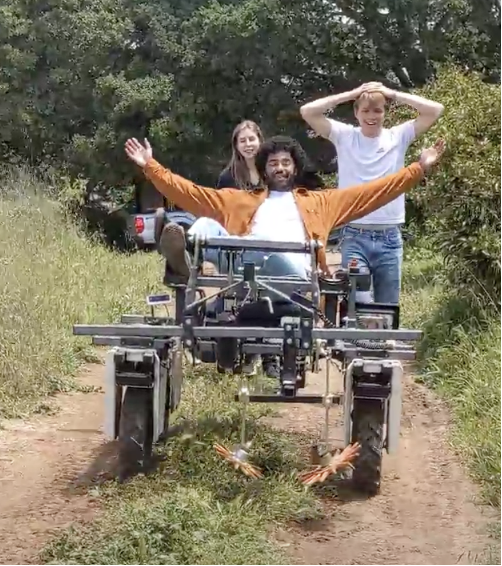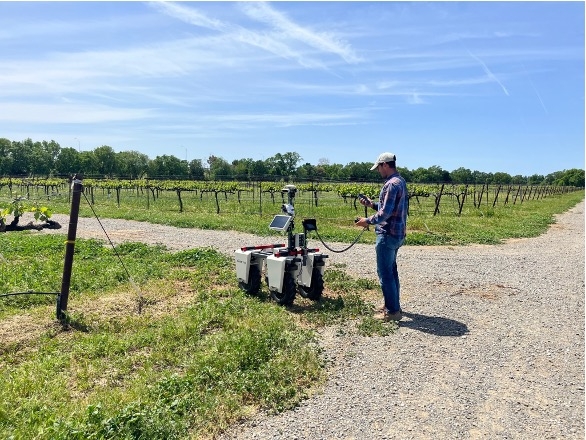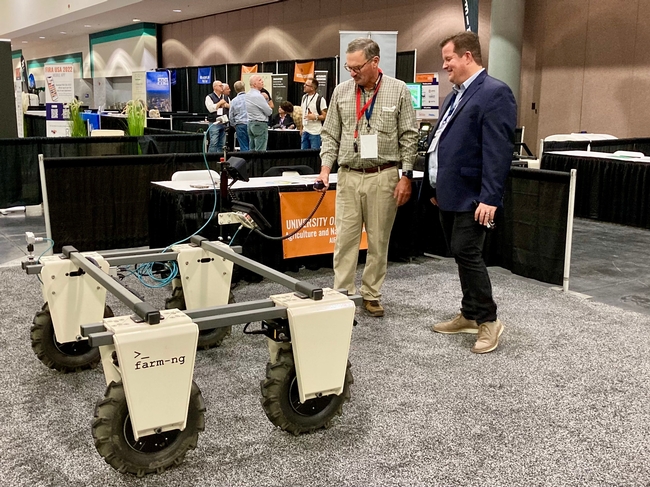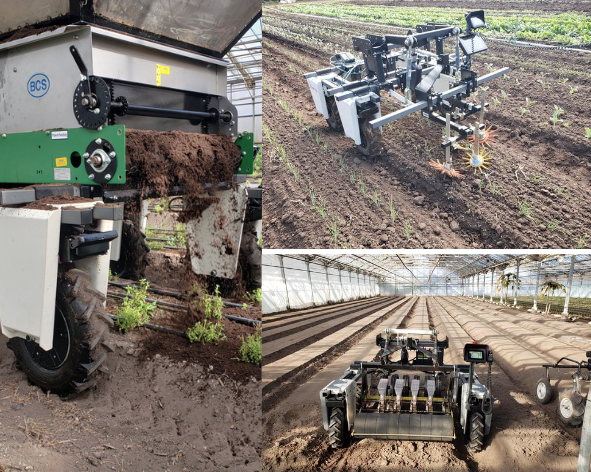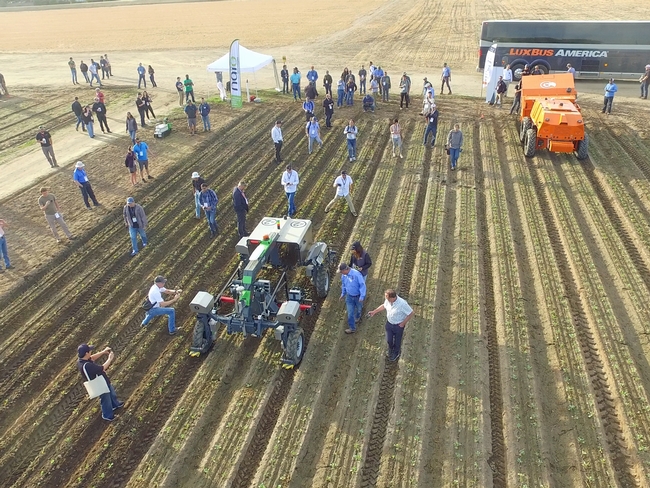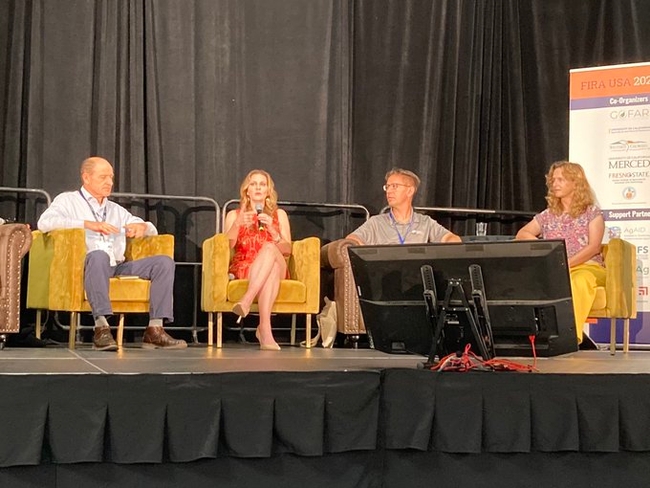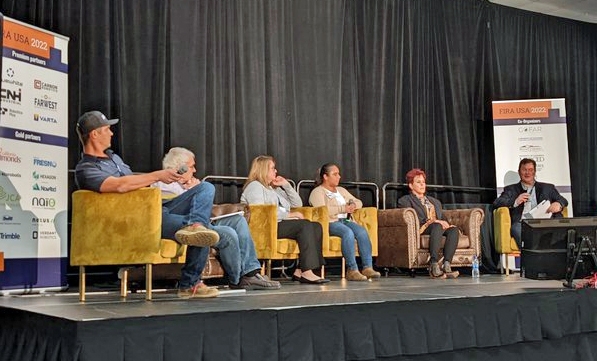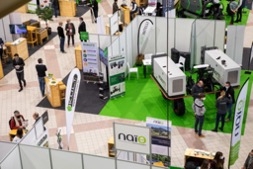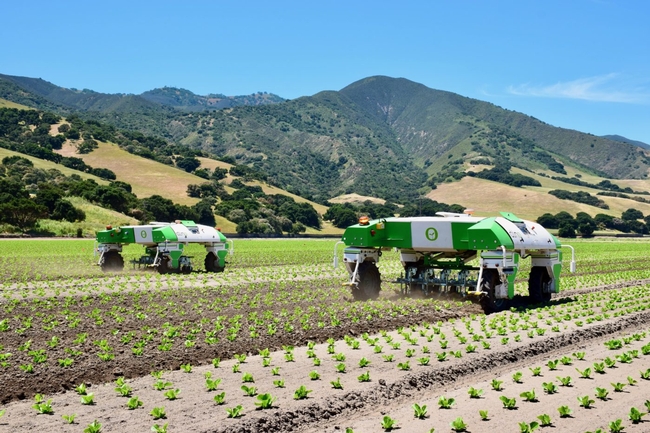Posts Tagged: robotics
Farm Robotics Challenge launches 2024 college competition
Students must form teams by Oct. 31; proposals due Nov. 15
Registration is now open for college teams competing in the 2024 Farm Robotics Challenge and proposals are due Nov. 15. The collegiate competition is organized by The VINE, an initiative of University of California Agriculture and Natural Resources, in collaboration with farm-ng, F3 Innovate and AI Institute for Next Gen Food Systems.
The Farm Robotics Challenge is an annual event where teams of students from universities and colleges across the United States tackle real-world farming challenges. The competition focuses on small-farm applications and leverages the state-of-the-art Amiga robot to integrate robotics into agricultural research. This year, the challenge is expanding by introducing a new division for two-year colleges, to allow more students to participate.
“The Farm Robotics Challenge is not just another competition; it's a transformative experience designed to cultivate the next generation of leaders in agricultural technology,” said Gabe Youtsey, UC ANR chief innovation officer and founder of The VINE. “By participating in this challenge, students are not only showcasing their technical skills, but also contributing to a larger mission — advancing sustainable and efficient farming practices for the future. We're incredibly excited to see the solutions that these young entrepreneurs will bring to the table.”
Teams are expected to address a variety of production farming topics, which can range from any crop or size of farm. The challenges for the competition are categorized into three main areas: Autonomy, which includes course navigation; Artificial Intelligence, focusing on vision and sensing as well as dataset collection; and Attachment, which involves the development of devices that can be attached to the robot for farm tasks..
“We're proud to join forces with the University of California Agriculture and Natural Resources for the second annual Farm Robotics Challenge," said Ethan Rublee, CEO of farm-ng. "With our Amiga robotics platform, our aim is to not only inspire the next wave of agricultural innovation, but also to prepare the workforce that will bring these innovations to life.”
Judging for the competition will be based on a range of criteria including the accuracy and completeness of the project, the elegance and ease of use in the design, safety measures, interdisciplinary inclusion, societal and economic impact, cost considerations, and the commercial and market potential of the solution.
The competition will consist of two main parts: market research, project proposal and fundraising; followed by development, coding and fabrication. Key dates include:
- Team formation deadline: Oct. 31
- Project proposal submission deadline: Nov. 15
- Development start: Jan. 31, 2024
- Judging: Sept. 6, 2024
Interested students, universities and investors are encouraged to visit the official Farm Robotics Challenge website at www.farmroboticschallenge.ai to fill out interest forms and get involved. The website also features detailed information about the challenges and judging criteria.
About The VINE
The VINE, an initiative of University of California Agriculture and Natural Resources, is California's agriculture, food, and biotech innovation network. Our mission is to harness the power of open innovation to help industries and entrepreneurs grow and scale globally while catalyzing technology innovation and commercialization for productive, sustainable and equitable food systems.
About AIFS
Established on Oct. 1, 2020, the Artificial Intelligence Institute for Next Generation Food Systems, or AIFS, aims to solve the world's biggest challenges to crop and food production facing our planet: ensuring a sustainable, nutritious, efficient and safe food supply while mitigating the impacts of climate change.
About farm-ng
Based in Watsonville, farm-ng is building general purpose off-road robotics hardware and software products. The company's mission is to transform the food system by democratizing access for the smallest farmer to cutting-edge robotics technology.
About F3 Innovate
Headquartered in California's Central Valley, F3 Innovate is the U.S. epicenter for climate-smart agrifood tech. With proximity to over 13,650 farms and 5 million acres of farmland, we collaborate with top research institutions to advance industry research and development. Supported by federal and state funding, F3 Innovate is geared to shape the future of sustainable food production worldwide.
Harvest-assisting robot wins Farm Robotics Challenge top prize
UC Davis, University of Nebraska and UC Santa Cruz teams honored for ag tech innovation
[Updated June 9, 2023, to add Guilherme De Moura Araujo to Amiggie advisors.]
A robot designed to reduce farmworker injuries and streamline harvest took the top prize in the Farm Robotics Challenge 2023. The challenge spotlighted the exceptional innovation and technical prowess of students from universities across the United States. Teams from UC Davis, the University of Nebraska and UC Santa Cruz were presented awards in a virtual ceremony June 3. Organized by the AI Institute for Next Gen Food Systems (AIFS), The VINE, Fresno-Merced Future of Food (F3) Innovation and farm-ng, the inaugural annual event celebrated student innovators' contributions to the advancement of agricultural technology.
The Farm Robotics Challenge, sponsored by Beck's Hybrids, provided a platform for students to demonstrate engineering, computer science, critical thinking and business skills. They engaged in real-world farming scenarios, creating and programming farm robots using the farm-ng platform. The contest demonstrated how students can apply technology and innovation against challenges in agriculture.
The awards ceremony recognized the following teams for their exceptional contributions:
Grand Prize Winner: Amiggie from UC Davis, a robot designed to assist human pickers and streamline harvest operations. The robot monitors risky postures, carries harvested crops, and streamlines the unloading process for increased efficiency.
Team advisors: Juan Fernando Villacres, Guilherme De Moura Araujo, Lance Halsted
Students:
- Kaiming Fu
- Yuankai Zhu
- Xuchang Tang
- Qikai Gao
- Shuchen Ye
- Hualong Yu
- Yihan Wu
- Jinduo Guo
- Hang Ji
- Xiaotan “Molly” Mo
Complexity in Design Prize: Huskerbot from the University of Nebraska-Lincoln, an innovative robot that combines machine learning and precise herbicide application for more sustainable farming.
Team advisor: Santosh K. Pitla
Students:
- Amlan Balabantaray
- Shaswati Behera
- Nipuna Chamara Abeysinghe Herath Mudiyanselag
- Krishna Muvva
- Kaden Monk
- Kashish Syed
- Zane Rikli
- Ryleigh Grove
Elegance in Design Prize:Robo-ag from UC Davis, an autonomous robot designed to target pesticide application to minimize chemical waste and environmental impact.
Team advisors: Mason Earles, Alex Olenskyj, Vivian Vuong
Students:
- Heesup Yun
- Earl Ranario
- Nishi Bhagat
- Riya Desai
- Connor Davainis
- Summer Reeves
- Amir Mazraawi
Small Farms Robot Design Prize: Electrified Slugs from UC Santa Cruz, autonomous navigation software that efficiently weeds plant lines on small organic farms.
Team advisors: Dejan Milutinovic, Darryl Wong
Students:
- Oliver Fuchs
- Joshua Gamlen
- Katherine Rogacheva
Gabe Youtsey, chief innovation officer of University of California Agriculture and Natural Resources and founder of the VINE, commended the competition's success.
"The Farm Robotics Challenge is about shaping the future of agriculture by inspiring the next generation of ag tech pioneers," said Youtsey. "The ideas that emerged from this competition are solutions for today's farming challenges, highlighting how technology can contribute to a more sustainable, productive and resilient food system."
Ethan Rublee, CEO/Founder of farm-ng, was highly impressed by the dedication, creativity and vision demonstrated by the student teams.
"The innovative solutions these students have engineered is a testament to their determination and ingenuity," Rublee noted. "They're not just addressing the challenges facing agriculture today — they're proactively anticipating the problems of tomorrow. It's truly exciting to imagine where their ideas will take us in the future."
Steve Brown, AIFS associate director, commended the students for being a part of a meaningful moment in the history of agriculture.
“With 2 billion more people to feed in the next 25 years, there are grand challenges that this generation realizes are directly in front of them, and they are meeting those challenges,” Brown said. “It was encouraging to see the imagination of this generation of makers of all talents leveraging technology, which is now able to bring their ideas to life.”
In addition to recognition and prize money — $10,000 for the Grand Prize Winner and $5,000 for each category winner — the Farm Robotics Challenge winners will have the opportunity to showcase their innovative projects at FIRA USA 2023 in September. This premier event in Salinas California serves as a global stage for agricultural technology innovation, presenting an opportunity for these young innovators to make their mark on an international level. Learn more about FIRA USA 2023 and register at https://fira-usa.com
“All participating teams deserve recognition for their dedication, hard work and innovative solutions,” said Youtsey.
Other competitors included Autonomous Pasture Weeding Robot and Autonomous Lettuce Weeding Robot from Cal Poly-San Luis Obispo; Team Klaatu from UC Santa Barbara; The Maize Runners from Brigham Young University; Team 307, Team 306, and Bobcats from UC Merced; TartanPest from Carnegie Mellon University; Children of the Corn, Dig Doug, and PruneScape from Purdue University; and SARDOG from Fresno State.
For more information about the Farm Robotics Challenge and future events, please visit https://farmbot.ai.
[Updated June 9, 2023, to add Guilherme De Moura Araujo to Amiggie advisors.]
Farm robotics competition challenges students to solve real-world problems
College students are invited to develop a robot that makes farm work easier while competing for cash prizes and bragging rights in the Farm Robotics Challenge, a three-month robotics development competition running from Feb. 1 to May 13, 2023.
The challenge is being sponsored by The VINE, an initiative of the University of California Agriculture and Natural Resources focused on agricultural innovation, in partnership with the AI Institute for Next Generation Food Systems (AIFS), farm-ng robotics company, and the Fresno-Merced Future of Food (F3) Innovation coalition.
"Our primary objective for the Farm Robotics Challenge is to empower young innovators to explore careers in agriculture technology and innovation," said Gabe Youtsey, chief innovation officer for UC ANR and head of the VINE. "The agrifood technology industry is one of the most exciting and fastest-growing sectors in the economy right now, estimated to reach $30.5 billion by 2050. Yet, because of a lack of exposure or access, our brightest minds end up entering other sectors, taking their talents and abilities with them. We hope this new competition changes that and reverses the talent flow back into agriculture."
“In order to have a next-generation food system, we need next-generation agricultural robotics developers,” said Steve Brown, AIFS associate director. “There is tremendous innovation potential in this domain that just needs more connecting points to the coders and makers.
The Farm Robotics Challenge is open to any university or college in the U.S. Student teams will be asked to address a production farming topic on any crop or size of farm, with a desired focus on small farms, by automating an essential farm-related task using the farm-ng robotics platform. Each campus will need to purchase a farm-ng robot or borrow one to participate in the challenge.
Specific challenges will either be pre-identified for teams to choose from, or teams may choose to create additional or custom functionality to solve a self-identified challenge. Challenges will fit into one or more of the following categories: autonomy, artificial intelligence or attachment. Virtual training sessions will be offered throughout the competition to provide teams with expert guidance and technical help from AIFS, farm-ng, The VINE and other partners.
Student teams will be judged on the following criteria, with a grand prize and several specific prizes for top teams in each category: accuracy and completeness, market fit and commercial potential, design elegance and ease of use, cost-effectiveness, safety, interdisciplinary inclusion, and social and economic impact. Winners will receive cash prizes and connections to robotic companies for internships and jobs, among other benefits.
For more information, please visit the Farm Robotics Challenge website at https://farmbot.ai. If you have questions, contact HannaBartram, AI Institute for Next Generation Food Systems education and public engagement coordinator, at hcbartram@ucdavis.edu.
First FIRA USA Ag Robotics Forum attracts people from around the world
Agriculture and the global food supply is threatened by a range of issues including drought, climate impacts, increasing business costs and labor scarcity. To forge solutions to these issues and more, nearly 1,000 attendees from 26 countries converged in Fresno on Oct. 18-22 for the inaugural FIRA - World Ag Robotics Forum to be held in the U.S. The event was co-sponsored by UC Agriculture and Natural Resources' The Verde Innovation Network for Entrepreneurship, or the VINE.
Widely observed as a pivotal moment for agricultural technology and robotics in U.S. agriculture, the event was kicked off by California Department of Food and Agriculture Secretary Karen Ross and moved into a packed agenda with panel discussions, lightning talks and pitches where automation company representatives, academics and growers had the opportunity to share their challenges, concerns and hopes for the future of autonomous farming. The event culminated at CSU Fresno with more than a dozen companies offering in-the-field demonstrations.
Although growers are the target market for most of the equipment, the benefits of automation can ripple out into society, according to Glenda Humiston, University of California vice president for agriculture and natural resources.
“Technology can help us grow, harvest and distribute food more efficiently so that it can become more affordable and accessible for those who are food insecure,” said Humiston. “If we do this right, it's good for the whole community.
Here are a few themes and takeaways from this pioneering multi-day event.
Gaining on-farm use - Focus on end-user needs and ease of use
A major question speakers tackled was why more growers aren't yet integrating automation on their farms. Automation solutions exist and are being developed to help growers in nearly every aspect of running a farm — from planting, harvesting and weeding to addressing persistent labor shortages. Despite this, ag automation companies – both big and small – still face resistance from growers to adopting new technologies.
Part of the problem, Jeff Morrison of Grimmway Farms said during a panel on mechanization versus automation, is that companies pay more attention to their product than the needs of the grower. “Farmers want technology that fills a particular need,” he said. Anna Haldewang, the founder of InsightTRAC, agreed. “Don't be married to your product, be married to your customer.”
Chuck Baresich, president of the Haggerty AgRobotics Company, emphasized the importance of creating automation solutions that are simple and intuitive to use. “For a manufacturer, the first thing I'd tell them is don't overcomplicate things,” he said. “Make sure your robot can drive straight, start with that.”
Panels also touched on the technical, business and regulatory challenges to automating agriculture. The ag tech startup market is much younger than Silicon Valley, and we don't yet know the best route to establishing a successful business, Rob Trice of Better Food Ventures and The Mixing Bowl observed during a panel on robotic product development with key industry leaders, including Walt Duflock, vice president of innovation for Western Growers. That said, panelists identified three things that startups should do:
- Get prototypes into the field as quickly as possible to get performance data and get feedback, including from farmworkers, who may come up with multiple uses for the product.
- Be transparent about development to build partnerships with investors and growers. Partners understand that startups are a work-in-progress.
- Be ready to evolve and change your technology or your business to meet the customers' needs. Love the customer, not the tech.
AgTech, Labor and Farmworkers - Forging win-win opportunities
Labor issues also emerged as a persistent theme during the event. One of the major forces driving the need for automation in agriculture is persistent labor shortages. Simply put, farmers do not have sufficient labor to sustain their operations and are turning to agtech, robotics and automation to fill the gap. At the same time, as robotics and automation take hold in the agriculture industry, farmworkers and farm labor organizations are rightly concerned about the impact that the adoption of automation will have on agriculture jobs, in particular farm labor jobs.
Hernan Hernandez of the California Farmworker Foundation acknowledges the labor concern, but also sees opportunity. “All of a sudden, you go from 100 individuals that are going to be able to harvest this season to now 10 that will harvest with a machine," he said. "But the way we look at it is as well, when we talk to farmworkers and engage them, and we look at data, there is also opportunity. We know a lot of the farmworkers want opportunities to further their skill sets.”
We've got to find ways to help our farm workers actually get the training they need to make use of this technology, which will give them a better quality of life.
This sense of optimism about the future of the farmworker was shared by Gabe Youtsey, chief innovation officer of UC ANR, who moderated a panel on the future of agricultural work. “California as a whole has begun recognizing the importance of creating the next generation of ag workers,” he observed, “and schools and industry have both taken notice.” Indeed, California community colleges have begun working on new relevant programs that translate directly to jobs, and the federal government has allocated $10 million going directly to Central Valley agricultural education and workforce development programs.
What's next?
The gathering also served as a platform for launching new technology initiatives. Youtsey, in collaboration with our partners at UC Davis AI Institute for Food Systems, announced the 2023 Farm Robotics Challenge at FIRA USA 22! We look forward to co-hosting this event!
It is clear that automation and robotics will play an increasingly crucial role in agriculture. Not only in addressing the pronounced labor shortage in agriculture, but by creating new value creation opportunities related to resource efficiency, crop health, disease, harvesting and more.
“Our job at The VINE is to drive collaboration between industry, academia and government forward,” said Youtsey. “Robotics is moving very fast and there's a new set of players coming into the space. UC Cooperative Extension advisors can bring startups and farmers together in creative new ways during development and advance these solutions into commercialization faster.”
Co-sponsors of the conference included FIRA, Western Growers, University of California, Merced, California State University, Fresno and the Fresno-Merced Future of Food (F3) Innovation Initiative.
Industry sponsors included Bluewhite, Carbon Robotics, CNH Industrial, Far West Equipment Dealers Association, Grimmway Farms, Keithly-Williams Seeds Inc., Robotics Plus, VARTA AG, and Sonsray Machinery, LLC.
For more information
- Subscribe to the FIRA Newsletter HERE and check the website for future events.
- Interested in the 2023 Farm Robotics Challenge?Learn more at https://farmbot.ai.
Robotics are solving water, fertilizer, labor challenges for California agriculture
Global event in Fresno aims to drive ag robotics forward Oct. 18-20, 2022
California agriculture is under tremendous threat from drought, climate impacts and labor scarcity. New robotics and automation solutions are addressing these challenges. To accelerate this innovation to market, a team of partners in California and the International Forum of Agricultural Robotics (FIRA), the leading event in agricultural robotics, will launch FIRA USA in Fresno, California, Oct. 18-20 to provide autonomous systems and robots to California and North America growers.
Jointly organized between the French association GOFAR, the University of California Agriculture and Natural Resources, Western Growers Association and the Fresno-Merced Future of Food (F3) Initiative, FIRA USA 2022 will bring together specialty crop growers, robot manufacturers, industry members, academics, technologists, startups and investors for three days of problem-solving, decision making and planning.
Since 2016, FIRA has primarily hosted its flagship event in Toulouse, France. According to FIRA co-directors Maialen Cazenave and Gwendoline Legrand, “The expert event decided to join forces with local players to launch the first edition abroad: FIRA USA was born.”
An event focused on autonomous solutions for specialty crops
Specialty crops have much to gain from ag robotics and automation. Specialty crops, which the U.S. Department of Agriculture defines as “fruits and vegetables, tree nuts, dried fruits and horticulture and nursery crops, including floriculture,” tend to be more labor intensive to produce and pick, and require more sophisticated technological solutions.
Walt Duflock, Western Growers vice president of innovation, is working to advance the pace of innovation in this sector through the Global Harvest Automation Initiative, which will be presented atFIRAUSA 2022. One of the initiative's goals is to automate 50% of specialty crop harvest in the next 10 years.
FIRA USA to debut in Fresno
“We really wanted to bring a FIRA event to the U.S. because the U.S. market for specialty crops is a key agriculture industry entry point for ag tech startups, so it makes perfect sense to have this event right in the heart of the San Joaquin Valley,” says Duflock. “FIRA USA organizes the entire specialty crop community – educators, commercialization folks, startup companies, and large and small growers—and puts the entire event focus on specialty crop automation for three days.”
From research to robots in fields: A rich three-day agenda
To help ensure the success of this first-time event, FIRA partnered with Gabriel Youtsey, chief innovation officer at University of California Agriculture and Natural Resources.
“FIRA USA is designed for developing practical, real-world solutions, which is the mission of UC ANR,” Youtsey said. “I'm thrilled to advance the ag robotics and automation ecosystem in the Central Valley through this event. Our overall goal is to accelerate the pace of innovation and industry adoption of new technologies that create sustainable growth and profitability of our agriculture industry.”
To keep the event focused on actionable outcomes, FIRA USA is structured to maximize opportunities for networking, learning and collaboration. Each of the three days has a theme: research and development, technology and business day and demonstration.
Oct. 18: The Research & Development Day
The R&D day will bring hundreds of scientists and students together.
This academic day will provide the opportunity for new agricultural technologists in universities around the country that are winning some of the new artificial intelligence grants for agricultural automation to present their projects.
By bringing this academic community together face-to-face in Fresno, FIRA USA aims to set priorities and focus on solving some pain points.
Oct. 19: The Technology & Business Day
With a full exposition zone, panel discussions, breakout sessions and networking times, the second day will bring together the autonomous solutions and end-users.
FIRA USA will engage growers in the conversation to make it real and make presentations more relevant for grower audiences.
In the panel discussions, breakout sessions and roundtables, the participants will build on several big-picture themes: understanding specific specialty crops, introducing different levels of automation and smart technologies, optimizing mechanization, prioritizing value for growers of all sizes, tackling labor shortage, addressing climate-smart objectives, determining appropriate ownership and maintenance models, and more.
Oct. 20: The Demo Day
On the third day, FIRA USA will host in-field robot demos at the California State University, Fresno campus farm.
o Harvesting, weeding, seeding, thinning and planting robots;
o Irrigation automation and data analytics solutions;
o Focus on field crops, fruits & vegetables and vineyards
FIRA USA will run from October 18 -20, 2022, at the Fresno Convention & Entertainment Center in California. The event is organized by FIRA; GOFAR; Western Growers; University of California, Agriculture and Natural Resources; Fresno State, Jordan College of Agriculture Sciences and Technology; and Fresno-Merced Future of Food Innovation.
To learn more about this upcoming event, visit www.fira-agtech.com/event/fira-usa.
ABOUT:
GOFAR
The GOFAR non-profit organization undertakes to promote and develop the agricultural robotics sector at international level. GOFAR meets the increasing need for visibility and networking of the agricultural robotics sector.
GOFAR, therefore, aims to organize the meeting between the relevant stakeholders, and to support them by taking an active part in the development of the agricultural robotics market hence implementing a promotional campaign of international scale (organization of events, production of actions of communication and participation of trade fairs in France and abroad).
The GOFAR association focuses its activity on four main work streams:
- Organizing annually the International Forum of Agricultural Robotics (FIRA), both Online and in-person in Toulouse (France);
- Setting up international collaborations;
- Development of an information platform around the Agricultural Robotics sector – www.agricultural-robotics.com;
- Creation and animation of a network of leading international experts in agricultural robotics.
Websites: www.fira-agtech.comandwww.agricultural-robotics.com
University of California Agriculture and Natural Resources
UC Agriculture and Natural Resources connects the power of UC science and technology in agriculture and natural resources with industry and communities to improve the lives of all Californians.
Our programs focus on solving priority problems that engage scientists, students and industry in integrated teams to work on complex issues.
ANR's field innovation centers located in important California agriculture regions, support research and education. Research projects deliver the highest-quality science to growers, industry and land managers.
Website: https://ucanr.edu
Western Growers Association
Founded in 1926, Western Growers represents local and regional family farmers growing fresh produce in Arizona, California, Colorado and New Mexico. Our members and their workers provide over half the nation's fresh fruits, vegetables and tree nuts, including nearly half of America's fresh organic produce. Some members also farm throughout the U.S. and in other countries, so people have year-round access to nutritious food. For generations, we have provided variety and healthy choices to consumers.
Websites: https://www.wga.com and http://www.wginnovation.com
Fresno-Merced Future of Food (F3) Innovation Initiative
The Fresno-Merced Future of Food (F3) Innovation Initiative seeks to develop world-recognized, “ClimateSmart Food and Agriculture Systems” that provide solutions to economic and environmental challenges within the Central Valley. These solutions will result in both technology that can be exported to solve global food production challenges and increased support for local and regional food systems, including organic production practices and small-scale and socially disadvantaged farmers. F3 champions sustainable food systems that meet human, and ecosystem needs, facilitated by innovation in technologies that are affordable, appropriately scaled and accessible to local farmers and food businesses, with applications for the global farming community.
F3 simultaneously advances workforce training and educational opportunities for local farm and food system workers to ensure just and equitable innovation processes and technology adoption. F3 is one element of the comprehensive Fresno DRIVE investment plan, a ten-year, community-led vitality strategy for inclusive and sustainable economic development in the Greater Fresno Region.
Media Contacts
GOFAR: Gwendoline Legrand – gwendoline@fira-agtech.com
Western Growers: Ann Donahue - adonahue@wga.com
Special thanks to our premium partners: VARTA, Blue White Robotics and Farwest Equipment Dealers Association

